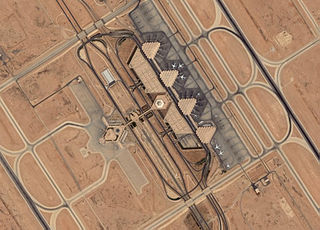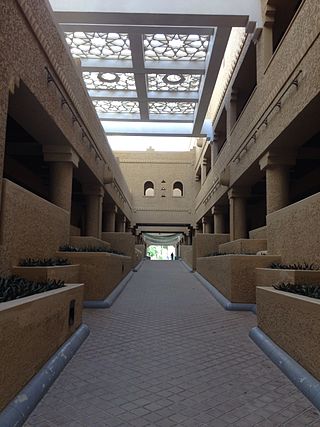
Riyadh is the capital and largest city of Saudi Arabia. It is also the capital of the Riyadh Province and the centre of the Riyadh Governorate. The current form of the metropolis emerged as an offshoot of the eponymous walled town following the dismantling of its defensive fortifications in the 1950s, after which the city underwent several phases of expansion and urbanization.

King Khalid International Airport is an international airport located about 35 kilometres (22 mi) north of Riyadh, Saudi Arabia, designed by the architectural firm HOK. Arabian Bechtel Company Limited served as the construction manager on behalf of the Saudi government.

The Aga Khan Award for Architecture (AKAA) is an architectural prize established by Aga Khan IV in 1977. It aims to identify and reward architectural concepts that successfully address the needs and aspirations of Muslim societies in the fields of contemporary design, social housing, community development and improvement, restoration, reuse and area conservation, as well as landscape design and improvement of the environment.

Kingdom Centre, formerly Kingdom Tower, is a 41-story, 302.3 m (992 ft) skyscraper in the al-Olaya district of Riyadh, Saudi Arabia. When completed in 2002, it overtook the 267-meter (876 ft) Faisaliyah Tower as the tallest tower in Saudi Arabia. It has since been surpassed and, as of 2021, is the fifth-tallest skyscraper in the country, whose tallest two buildings are the Abraj Al Bait Towers and the Capital Market Authority Tower. It is the world's third-tallest building with a hole after the Shanghai World Financial Center and the 85 Sky Tower in Taiwan. It contains the King Abdullah Mosque, which is the world's most elevated mosque from ground level.

Tuwaiq Palace or Towaiq Palace is a building in the Diplomatic Quarter district of Riyadh, Saudi Arabia, which hosts government functions, state receptions, and cultural festivals that introduce Saudi arts and customs to the international community. Named after the nearby Tuwaiq mountain, it was built in 1985 by OHO Joint Venture, a team composed of Frei Otto, Buro Happold, and Omrania. Tuwaiq Palace won the Aga Khan Award for Architecture for the design in 1998.
Abdel-Wahed El-Wakil is an Egyptian architect who designed over 15 mosques in Saudi Arabia and is considered by many as the foremost contemporary authority in Islamic architecture. For designing in traditional styles, he is also a representative of New Classical Architecture.

Articles related to Saudi Arabia include:
The following is a Gregorian timeline of the history for the city of Riyadh, Saudi Arabia.

The Public Investment Fund (PIF) Tower is a 385 m (1,263 ft) skyscraper in Riyadh, Saudi Arabia. Construction started in 2010 and was topped-out in 2014. The building was finally completed in 2021, making it the tallest building in Riyadh, surpassing Burj Rafal, and the second-tallest in Saudi Arabia. Designed by HOK and Omrania, the 76-story PIF Tower is one of the most high-tech skyscrapers in the world and the centerpiece of the King Abdullah Financial District.

King Abdullah Financial District is a mixed-use financial district located in the al-Aqeeq neighbourhood of Riyadh, Saudi Arabia Managed by the King Abdullah Financial District Development and Management Company, a wholly-owned subsidiary of the Kingdom's Public Investment Fund. The district was previously being managed by the Rayadah Investment Corporation on behalf of the Pension Authority of the Kingdom of Saudi Arabia. The district is the largest LEED Platinum certified mixed-use business centre in the world.

Saudi Vision 2030 is a government program launched by Saudi Arabia which aims to achieve the goal of increased diversification economically, socially and culturally, in line with the vision of Saudi Crown Prince and Prime Minister Mohammed bin Salman. It was first announced on 25 April 2016 by the Saudi government.

KAFD World Trade Center is a skyscraper in the King Abdullah Financial District of Riyadh, Saudi Arabia. It was completed in 2022 and is the fourth tallest building in the country at 304 metres (997 ft), with 67 floors and nearly 1,500,000 square feet (140,000 m2) of floor space. The Abraj Al Bait, Capital Market Authority Headquarters, and Burj Rafal are taller, while KAFD is slightly taller than the older and well-known Kingdom Centre. The tower was designed by Gensler.

King Salman Park is an under construction large-scale public park and urban district in Riyadh, Saudi Arabia. It was unveiled in 2019 as one of the public initiatives to increase the green space of Riyadh. Being built on the grounds of former Riyadh Air Base and covering most of King Abdulaziz District, it is slated to be the largest urban park in the world upon its opening in 2026. The park has lent its name to the nearby district of King Salman Neighborhood that are named after King Salman bin Abdulaziz, the ruler of Saudi Arabia since 2015.

The KAFD Grand Mosque is the Juma’ah (Friday) mosque and an architectural centerpiece of the King Abdullah Financial District in Riyadh, Saudi Arabia. The 6,103-square-meter structure sits on a large urban plaza that functions as a public space and, when needed, outdoor prayer area. Inside, the column-free space can accommodate 1,500 prayer spaces over two levels — a large central hall and a mezzanine. Designed by the Riyadh-based architecture and engineering firm Omrania and Associates, the mosque is inspired by the form of the desert rose.

The Royal Commission for Riyadh City (RCRC) (Arabic: الهيئة الملكية لمدينة الرياض), formerly The Arriyadh Development Authority (ARA) and The High Commission for the Development of Arriyadh, is a royal commission established in 1974 during the reign of King Faisal bin Abdulaziz which was tasked with overseeing urban, economic, social and cultural development of Riyadh, the capital of Saudi Arabia.

Salam Park is a 61-acre historic urban park in Riyadh, Saudi Arabia, located southwest of Qasr al-Hukm District. Opened in 2004, it was built on the site of an eponymous date palm orchard that belonged to Prince Abdullah bin Abdul Rahman. The park is popular for its 3.3 hectares large artificial lake and 1-kilometer long pedestrian track. It was jointly designed by Omrania and Associates and Aukett Fitzroy Robinson. The Salam Mosque, one of the oldest and earliest reinforced concrete mosques of Riyadh, is situated at the center of the park.

Al-Kindi Plaza, or Al-Kindi Square, is a multipurpose market square in Diplomatic Quarter, Riyadh, Saudi Arabia, located next to the Cultural Palace. Completed in 1986, it is named after the 9th century Arab philosopher and polymath Abu Yusuf al-Kindi. It includes a congregational mosque, library, garden, courtyard and the offices of the Royal Commission for Riyadh City and the MiSK Foundation.

Al-Hamra Palace, better known as the Red Palace is a historic palace and a cultural landmark located in the al-Fouta neighborhood of Riyadh, Saudi Arabia. Commissioned in 1943 by King Abdulaziz ibn Saud as a gift to his son and future monarch, Prince Saud bin Abdulaziz, it served as the latter's main residence and workplace from its completion in 1948 until he moved to the al-Nassiriyah Palace in 1956. It is the first reinforced concrete structure in the history of Saudi Arabia and its layout and design were modeled after the historic British Residency building in Hyderabad, India. It was opened to the general public in 2019 after being abandoned for almost 17 years. Since 2022, the palace compound is owned by the Boutique Group, which is set to transform the building into a luxury hotel.
Riyadh Art is a public art project in Saudi Arabia. It is one of Riyadh’s four megaprojects launched by King Salman bin Abdulaziz in March 2019, and one of the largest public art projects in the world. It is overseen by the National Megaprojects Committee led by Crown Prince Mohammed bin Salman bin Abdulaziz, Prime Minister and Chairman of the Board of Directors of the Royal Commission for Riyadh City. The project is one of the initiatives that contribute to the Kingdom’s Vision 2030.















